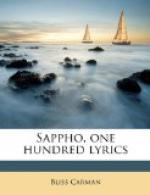It should be noted, however, that while primarily rare masterpieces are included in the “King’s Classics,” modern popular classics, more especially such as have not yet been adequately or at all annotated, are not excluded from the Series.
* * * * *
Note.—At the date of this list,
May 1, 1907, Nos. 1-35 were published.
Numbers subsequent to 35 are at press or about to
go to press.
The “King’s Classics” are printed on antique laid paper, 16mo. (6 X 4-1/2 inches), gilt tops, and are issued in the following styles and prices. Each volume has a frontispiece, usually in photogravure.
Quarter bound, antique grey boards, 1/6 net.
Red Cloth, 1/6 net.
Quarter Vellum, grey cloth sides, 2/6 net.
Special three-quarter Vellum,
Oxford side-papers, gilt tops, silk
marker, 5/- net.
***Nos. 2, 20 and 24 are double
volumes. Price, Boards or Cloth, 3/-
net; Quarter Vellum, 5/- net;
special three-quarter Vellum, 7/6 net.
1. The love of books: being the Philobiblon of Richard de Bury.
Translated by E.C. Thomas. Frontispiece, Seal of Richard de Bury (as Bishop of Durham).
3. The chronicle of JOCELIN of BRAKELOND, Monk of st. Edmundsbury: a Picture of Monastic and Social Life in the XIIth Century.
Newly translated, from the original Latin, with notes, table of dates relating to the Abbey of St. Edmundsbury, and index, by L.C. Jane, M.A., sometime Exhibitioner in Modern History at University College, Oxon., and with an Introduction by the Right Rev. Abbot Gasquet. Frontispiece, Seal of Abbot Samson (A.D. 1200).
***20. The nun’s Rule, or Ancren Riwle, in Modern English.
Being the injunctions of Bishop Poore intended for the guidance of nuns or anchoresses, as set forth in the famous thirteenth-century Ms. referred to above.
Editor, the Right Rev. Abbot Gasquet. Frontispiece, Seal of Bishop Poore.
Double volume.
17. Mediaeval, lore.
From Bartholomaeus Anglicus. Edited with notes, index and glossary by Robert Steele. Preface by the late William Morris. Frontispiece, an old illumination, representing Astrologers using Astrolabes.
[The book is drawn from one of the most widely-read works of mediaeval times. Its popularity is explained by its scope, which comprises explanations of allusions to natural objects met with in Scripture and elsewhere. It was, in fact, an account of the properties of things in general.]
11. The Romance of Fulk FITZWARINE.
Newly translated from the Anglo-French by Alice Kemp-Welch, with an introduction by Professor brandin. Frontispiece, Whittington Castle in Shropshire, the seat of the Fitzwarines.




